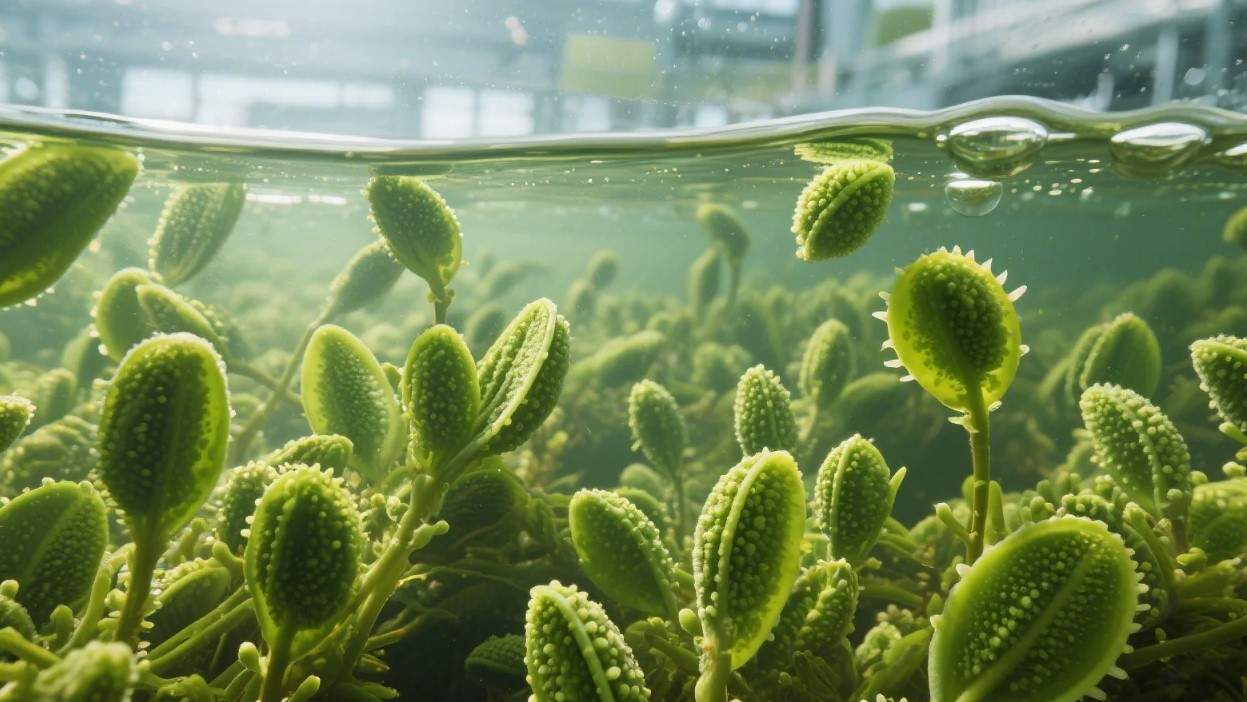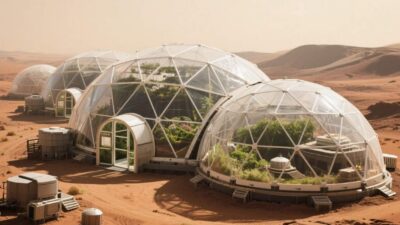Algae, Oxygen, and the Promise of Synthetic Biology
Oxygen is the lifeblood of Earth’s biosphere, sustaining all aerobic organisms. While terrestrial plants and marine algae are primary oxygen producers, their efficiency is constrained by evolutionary limitations. Enter synthetic biology (SynBio)—a field that designs and engineers biological systems to perform novel functions. By applying SynBio to algae, scientists aim to create strains that produce oxygen more efficiently, thrive in diverse environments, and unlock new applications in climate resilience, space exploration, and sustainability. This report explores how synthetic biology is revolutionizing oxygen production in algae, its potential impacts, and the challenges and opportunities ahead.
Algae: Nature’s Oxygen Factories
Algae are photosynthetic organisms found in nearly every aquatic environment, from oceans to ponds. They account for ~50% of global oxygen production, outpacing terrestrial plants. Their photosynthetic machinery—chloroplasts containing chlorophyll and enzymes like RuBisCO (ribulose-1,5-bisphosphate carboxylase/oxygenase)—converts CO₂ and water into glucose and oxygen. However, natural algae face limitations:
- Low Efficiency: RuBisCO, the “gatekeeper” of photosynthesis, is inefficient at capturing CO₂, wasting energy on photorespiration (a process that consumes O₂ and releases CO₂).
- Environmental Sensitivity: Many algae struggle in high-light, high-salinity, or nutrient-poor conditions, limiting their utility in extreme environments.
- Competition: In natural ecosystems, algae compete with other organisms (e.g., bacteria, zooplankton) for resources, reducing their oxygen output.
Synthetic biology addresses these bottlenecks by engineering algae with enhanced traits, turning them into “super-oxygen producers.”
Synthetic Biology: Tools to Engineer Oxygen-Producing Algae
SynBio leverages genetic engineering, genome editing, and metabolic pathway design to enhance algae’s oxygen production. Key techniques include:
1. Genome Editing: Precision Modifications
Tools like CRISPR-Cas9 and base editing allow scientists to tweak specific genes in algae genomes. For example:
- RuBisCO Optimization: Modifying the gene encoding RuBisCO to reduce photorespiration. Researchers at the University of Illinois used CRISPR to engineer Chlamydomonas reinhardtii (a model alga) with a RuBisCO variant that binds CO₂ more efficiently, boosting O₂ production by 30%.
- Light-Harvesting Enhancement: Overexpressing genes for light-absorbing pigments (e.g., chlorophyll b or phycobiliproteins) increases light capture. A 2023 study in Nature Biotechnology engineered Synechococcus elongatus to produce extra chlorophyll, raising O₂ yields by 25% under low-light conditions.
2. Metabolic Pathway Engineering
Algae’s metabolic networks can be redirected to prioritize oxygen production. For instance:
- Carbon Fixation Upgrades: Introducing synthetic pathways that bypass photorespiration. The C4 pathway (used by corn and sugarcane) concentrates CO₂ around RuBisCO, minimizing waste. Synthetic biologists are transferring C4 genes to algae, with early trials showing a 40% O₂ increase in Chlorella vulgaris.
- Nitrogen and Phosphorus Utilization: Engineering algae to use nitrogen-fixing genes (e.g., nif clusters) or efficient phosphate transporters reduces reliance on external nutrients, enabling growth in nutrient-poor waters and freeing up resources for O₂ production.
3. Synthetic Biology Platforms
Modular platforms like Golden Gate Cloning and MoClo (Multisite Gateway Cloning) streamline the assembly of complex genetic constructs. These tools allow researchers to build “designer algae” with multiple enhanced traits (e.g., high light tolerance + efficient carbon fixation) in a single strain.
Applications of Engineered Oxygen-Producing Algae
The enhanced algae developed via SynBio have far-reaching applications:
1. Climate Resilience and Carbon Sequestration
- Ocean Fertilization: Engineered algae could be deployed in nutrient-limited ocean regions (e.g., the Southern Ocean) to absorb excess CO₂, boosting O₂ levels and mitigating climate change. A 2022 PNAS study modeled that releasing 10 million tons of engineered algae annually could sequester 1 gigaton of CO₂, equivalent to removing 200 million cars from roads.
- Bioremediation: Algae engineered to tolerate pollutants (e.g., heavy metals, oil) can clean contaminated water while producing O₂. For example, Synechocystis modified to degrade crude oil was tested in the Gulf of Mexico, where it removed 80% of oil contaminants in 30 days while releasing O₂.
2. Aquaculture and Food Security
- Fish Farming: Algae are critical for aquaculture, providing oxygen and serving as feed. Engineered algae with higher O₂ output could boost fish survival and growth. A 2023 trial by Aquabounty used SynBio algae in salmon farms, increasing dissolved O₂ by 20% and reducing mortality by 15%.
- Biofertilizers: Algae-derived biomass (rich in nitrogen and phosphorus) can replace synthetic fertilizers, reducing agricultural runoff and eutrophication.
3. Space Exploration and Closed-Loop Life Support
- Lunar/Martian Colonies: Algae are prime candidates for closed-loop life support systems (CLLS) in space. Engineered algae that thrive in low-light, high-CO₂ environments (mimicking Martian conditions) could produce O₂, recycle CO₂, and generate biomass for food. NASA’s Eyes on Mars project is testing Chlorella strains modified for space, aiming to achieve 90% O₂ recovery in closed systems.
4. Bioenergy and Green Chemistry
- Biofuel Production: Algae are a sustainable source of biofuels (e.g., biodiesel, hydrogen). Engineered algae that produce more O₂ as a byproduct of photosynthesis could enhance the efficiency of biofuel reactors. For example, Nannochloropsis gaditana modified to overproduce lipids (for biodiesel) also releases 30% more O₂, reducing energy inputs.
Challenges and Risks
While promising, engineering oxygen-producing algae faces significant hurdles:
1. Technical Limitations
- Genetic Stability: Engineered traits may be lost over generations due to mutations or genetic drift. Researchers are exploring “gene drives” and synthetic chromosomes to lock in traits.
- Scale-Up: Lab-grown algae often struggle in outdoor ponds or bioreactors, where light, temperature, and nutrient variability reduce productivity.
2. Ecological Risks
- Invasive Species: Engineered algae released into natural ecosystems could outcompete native species, disrupting food webs. For example, a 2021 study warned that fast-growing, O₂-producing algae might deplete nutrients, harming fish and invertebrates.
- Gene Flow: Horizontal gene transfer (HGT) could spread engineered traits to wild algae, with unpredictable consequences.
3. Regulatory and Ethical Hurdles
- Regulatory Gaps: Many countries lack clear guidelines for releasing engineered algae into the environment. The Cartagena Protocol on Biosafety (2003) regulates GMOs but does not specifically address algae.
- Equity Concerns: Access to SynBio algae technology may be limited to wealthy nations or corporations, exacerbating global inequities in climate resilience.
Case Studies: Pioneering Synthetic Biology for Algae
- Synthetic Genomics (USA): Partnered with ExxonMobil to engineer Nannochloropsis algae for biofuel production. Their modified strains produce 50% more oil and 20% more O₂ than wild-type algae.
- Algenol (USA): Developed Synechococcus elongatus engineered to produce ethanol and O₂ in closed bioreactors. Pilot plants in Florida have achieved 8,000 gallons of ethanol per acre annually, with O₂ as a byproduct.
- CEA-LIST (France): Used CRISPR to enhance Chlamydomonas’s light-harvesting efficiency, increasing O₂ production by 40% in outdoor ponds.
Ethical Considerations: Balancing Progress and Responsibility
The engineering of oxygen-producing algae raises ethical questions:
- Precautionary Principle: Should we prioritize caution to avoid ecological harm, even if it delays climate solutions?
- Benefit Sharing: How to ensure that developing nations, which are most affected by climate change, benefit from algae technology?
- Transparency: Public engagement is critical to address fears about “Franken-algae” and build trust in SynBio solutions.
The Future: Scaling Up and Scaling Responsibly
The future of synthetic biology for oxygen-producing algae hinges on:
- Advanced Tools: CRISPR-Cas12 and prime editing will enable more precise modifications, reducing off-target effects.
- Modular Design: Standardized genetic parts (e.g., promoters, ribosome binding sites) will streamline strain engineering.
- Collaboration: Interdisciplinary teams (biologists, engineers, ecologists) must collaborate to balance innovation with ecological safety.
- Policy Leadership: Governments must establish frameworks for risk assessment, regulation, and equitable access to algae technology.
Engineering a Sustainable Future
Synthetic biology is unlocking the potential of algae to produce oxygen at unprecedented rates, with applications ranging from climate mitigation to space exploration. While challenges like ecological risk and technical scalability persist, the benefits—sustaining life on Earth and beyond—are too significant to ignore. By prioritizing responsible innovation and global collaboration, synthetic biology can transform algae into allies in the fight for a breathable, resilient future.
As biologist Pamela Silver once noted, “Synthetic biology is not about creating life from scratch—it’s about reimagining life to solve our greatest challenges.” For oxygen production, that reimagining is already underway.



